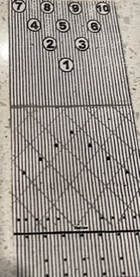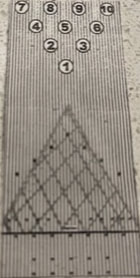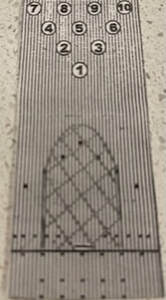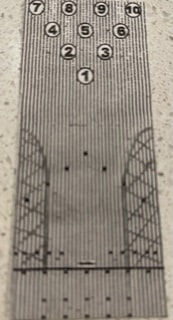|
As you know, getting MORE REVS on the ball will give you more hook and action at the pins, and will help you achieve getting more strikes.
Another very vital part of the bowling game is that of "ACCURACY". Having LESS REVS on the ball will help you to be more accurate when going for your spares, because less hook means your ball will be going more straight and have less chance to hook away from the pin you are aiming for. Practicing getting the ball out and over the same board or arrow repeatedly will help your aim to improve and increase your accuracy. The less curve on a ball, the greater the accuracy is going to be. If you can learn to throw a straighter ball for your spares for example, you will always be able to convert them when lane conditions change. As previously mentioned, to be able to throw a straight ball, you need to keep a flat hand at the stance, through the downswing, on the backswing, and through the ball release without any turning of the hand or arm. It's also important to keep your body square to the target. You may also want to learn to throw a straight ball if the lanes are dry and your ball is hooking too much! 1. Holding your ball up higher at the stance will help you achieve a higher back swing causing more speed and less hook which in turn will equal more accuracy. 2. If you can use more speed during your walk along the approach, the faster you will be able to throw your ball which will cut down on the hook. If this is difficult, you can try moving back 3-4" on the approach at the stance. This will cause you to walk faster in order for you to be able to reach the foul line in the same amount of steps. (Remember to do this in practice first and once you master changing speed, you can do it in the league when the scores are counting). 3. Lofting the ball out a little farther down the lane than normal will give the ball less lane to travel on, thereby cutting down the hook time. Just look at a target a bit farther down the lane. 4. Oily lane conditions (Tight Lanes) will also make the ball skid more, and will lessen the hook. 5. Keeping the pointer and pinky fingers closer together rather than spreading them out will lessen the hook. Without ACCURACY, ACTION will not be very effective. If you're not accurate in getting the ball over the proper mark, chances are slim that you will carry a strike. Some people with large hooks that barely touch the head pin can get a lucky strike if they get a good mix on the pins, but luck eventually runs out and I rather be more accurate on getting my ball over my mark each time and getting a strike solid in the pocket! Practicing doing the same things over and over again, will increase your accuracy! If you are a beginner, you can look at 3 boards instead of 1 for your target which will leave some room for error. As long as you are getting the ball within those 3 boards, you can adjust at the stance. When you get good at rolling the ball in that area, then try narrowing down your target to a smaller area like 1 board or arrow. Remember, Patience is a Virtue", and Rome wasn't built in a day! I'll be traveling over the summer months so join me back here in August when I'll be discussing "What is a Washout Spare Leave in Bowling"? Good Luck and High Scoring!
0 Comments
There are about FOUR GENERAL OIL PATTERNS that will appear on the lanes in league play, and most of them are approximately 40 feet long. Using a 2:1 ratio of moving your feet two boards and your target area 1 board (in the same direction) can help you on these different patterns. Experiment during league practice so you'll be ready when the actual scoring begins.
2. CHRISTMAS TREE PATTERN- The Oil Machine applies the oil in the shape of a Christmas tree or triangular shape. It allows the lesser hooking bowler to play along the edge of the lane where there is less oil, letting the ball hook back nicely into the desired pocket area.The heaviest oil will be on boards 15-25. As the oil breaks down, try to make angle adjustments, meaning to adjust more boards at the stance and less at the target area. An example would be if you need to move to the left 3 boards, then only move your target 1 board left at the arrows. The pattern looks like this: 3. BLOCK OIL PATTERN-This one is also a simple pattern and the one most often used in bowling centers. The most concentration of oil is in the center part of the lane and less on the outer portion. This is also known as a “WALL”, where the wall of friction is on those outside boards. For a Hook bowler, this is usually a very high scoring pattern. The ball needs to be placed where the oil is, angled to the edge where the friction increases (area with less oil), and then it should hook back into the pocket. This pattern can also be referred to as the “RED” pattern by the USBC. 4. REVERSE BLOCK OIL PATTERN- This is the opposite of the Block pattern. Most of the oil here is concentrated on the outer boards with very little in the center. This is a difficult pattern for those of us that throw a hook since there is very little oil. The ball will hook a lot more and possibly cross over into the 1-2 pocket for a righty or the 1-3 pocket for the lefty. You would have to adjust by moving quite a bit left at the stance. If you throw a straight ball, you are in luck! Remember to observe where the breakpoint is (where there is less oil), and make small adjustments from there. The more you can practice these oil patterns, the quicker you will master them and in turn, the better your scores are going to be. There are lots of other oil patterns used mostly by professionals and in some amateur tournaments that I will be discussing later on in my blog. Check out my book available on Amazon/Kindle--"Let's Rev Up Those Bowling Scores". https://www.amazon.com/dp/B09ZSMB99G/ref=sr_1_2?crid=P3PQWHFB1WYS&keywords=lets+rev+up+those+bowling+scores&qid=1652035291&sprefix=lets+rev+up+those+bowling+scores%2Caps%2C76&sr=8-2 Join me next week when I'll be discussing "How Can I Improve My Bowling Accuracy"? Good Luck and High Scoring! You throw your ball and it comes back on the ball return. You pick it up for your next shot and notice there’s a greasy circle around it's circumference. You think to yourself, “ What is this stuff all over my ball”?
Well, years ago the lanes were made of wood, the first 15 feet being a hardwood like maple, to be able to withstand the impact of the ball coming onto the lane. The remaining 45 feet was made of a softer wood like pine which was less expensive. OIL was put on the lanes to protect this wood. Without the oil, the ball would spark and put a burn mark on the lane from the friction! During the 1940’s, the lanes were COATED with SHELLAC to protect the wood underneath from friction and impact of the ball. However, Shellac became more difficult to make during World War II, so they changed the dressing on the lane to be Lacquer but this had a higher flammability, so they just decided to change the material the lanes were made of instead. This lane OIL or Dressing placed on the lanes consists of about 95% MINERAL OIL and the remaining mixture is consisted of other solvents. This oil mixture helps with ball friction and how far the oil gets pushed down the lane from the ball over a certain amount of games. Even though today most lanes are not made of wood, oil is still put down mostly to help bowlers control the new more aggressive balls, and to challenge bowlers abilities by using specific OIL PATTERNS approved by the USBC (United States Bowling Congress). The lane oil can affect the direction and reaction of your ball on the lane. Recently, the PBA (Pro Bowlers Association) introduced a new oil with a blue dye in it so the oil pattern can be seen. Normally league bowlers cannot see the oil pattern but must figure it out for themselves. There are several different patterns that we will be discussing in some of my later blog posts. Inside and outside TEMPERATURES can affect the oil and how your ball will react on the lane. I remember getting a really cold winter when I first began to bowl, and my scores were several pins down from what my normal average was. I was blaming it on the worker there who applied the oil to the lanes and asking if he had put more oil down than usual. The guy in the pro shop told me they were putting down the same amount, so I did a little bit of research and found out that it was this colder weather and the higher humidity we were getting with all the snow. My ball wasn’t hooking as much and was traveling down the lane farther than usual before it started to hook (the break point). The lane oil had become more congealed and the ball couldn’t begin it’s roll at the proper place as before. It was literally sliding on the oil and causing me to get more splits than usual. The ball needed to be in it’s ROLLING PHASE when it hit the pins for the strike to carry. So if the weather changes where you are, you need to pay a bit more attention to how the ball is going down the lane, and you also need to make more adjustments at the stance. Normally your ball will start to hook into the 1-3 pocket (1-2 pocket for lefty’s) on the last 20 feet of the 60 foot lane, but if there’s a lot of oil or it’s congealed from colder temperatures, your ball will NOT be able to hook as much, but will SKID, so you must compensate for this by moving to the right at the stance and have a more direct angle into the pocket. Your ball picks up the oil and carries it down the lane closer to the pins, so after a game or two your ball will start to hook later so you may need to move a little to the left. This is called "Carry Down Oil". Urethane balls don't absorb as much of the oil as the REACTIVE RESIN bowling balls do, but it’s very important to wipe your ball off every few frames to remove any oil or debris that is on the ball. If the ball absorbs too much lane oil over time, it will NOT react the same way it did when it was new. Try to clean your ball really well after about 12-15 games. They have ball cleaning products in the pro shop that you can use after your set of games is finished so your ball will be nice and clean before you bowl the next time. I would also sometimes SOAK mine in very hot tap water in the sink with “Dawn” liquid dish detergent for about 20-30 minutes and it cut through the grease really well. (I removed any hole tape beforehand). I was able to submerge the whole ball in the deep sink I had in my laundry room. If you have a small sink, just put in half at a time. By doing this, the ball will react like when it was new for a longer period of time and you won’t have to buy a new one for awhile. TIP: On most simple house patterns in leagues, you'll find that the oil is in the CENTER of the lane. If you want your ball to hook a bit more, try standing to the right and aim between boards 1-5. Try this in your practice sessions first because it may drop off into the channel several times until you get used to rolling the ball along the edge of the lane. Please leave me any comments in the comments area, or any topics you'd like me to discuss here in my Blog. I have several we will be covering in the near future. I look forward to hearing from you. Join me next week when I’ll be discussing "What Are the Most Common Oil Patterns in Bowling" that you will be encountering in league your bowling. Good luck and high scoring!! Here are a few more basics that you'll need to know in order to keep improving your game. Practice these one at a time during your practice sessions and begin to incorporate them into every game. The more games you bowl, the more these principals will become automatic and you won’t have to even think about them. Invest the time now for learning, and over time, you will have a more enjoyable bowling experience because you will be getting much higher scores!
8. TIMING is #1 in Bowling so try to COUNT YOUR STEPS as you are walking on the approach so you get a nice rhythm and do the same thing each time. When I don’t count, I find that sometimes my timing does get a bit off and I end up going too fast, or too slow. Your consistency changes if your speed keeps changing. 9. LOFT TO THE SAME AREA ON THE LANE- You need to really REACH OUT and LOFT the ball out about 2 feet onto the lane after the release. DO NOT drop it right at the foul line. If you throw a large hook, it will probably end up in the channel before it ever hits the pins. To practice this, you can place a small towel on the lane a few feet from the foul line and keep practicing to land your ball smoothly onto the towel. 10. LAND YOUR BALL SMOOTHLY onto the lane, not into it hard or you’ll lose striking power by the time the ball hits the pins. 11. Keep your EMOTIONS IN CHECK! What I mean by this is if you miss a spare or a needed strike, try not to lose your cool and get angry. I used to do this all the time when I first started bowling and ended up doing poorly because I let my anger get the best of me. I would stay focused on what I did wrong rather than what I needed to correct for the next shot. Remember to take each frame separately. If you have a bad shot, just try to figure out what you did wrong before it’s your next turn so you won’t have a repeat of what you just did, and just move on. Don’t dwell on past frames since you can’t re-do them. Take a few deep breaths to help you stay calm and focused! 12. Getting a GOOD LIFT on the ball is really important. Try to keep your middle fingers a little stiff so they stay in a slightly bent position. If you can, try and touch the back of your bowling shoulder each time after you release the ball which will also insure a good LIFT as I previously mentioned in an earlier Blog Post. Good lift also puts more revolutions on the ball which equals more action down at the pins. 13. TRUST IS A MUST OR YOUR GAME IS A BUST! What this means is to trust your ball to hook back into the pocket area, as long as you get it over the correct target. You don’t need to force it, try to steer the ball, or do anything fancy with it. DON’T try to AIM it , just do the normal 10:00 or 11:00 release and give the ball a chance to work. 14. THINK BEFORE YOU GET UP ON THE APPROACH- Once you know where you are going to stand and where your target should be, then step onto the approach and just “FEEL” the shot and be confident and deliberate. Some of these basics are easier said than done, but you need to stay focused and in control to be successful in bowling. Only you can control your game, so learning these things early on will help you to improve more quickly. Join me here next week for a discussion about “Why Do They Oil Bowling Lanes"?” Good Luck and High Scoring this week! |
AuthorHello!! My name is Joanie. Although I'm not a professional bowler, I have loved the sport for more than 45 years, averaged over 200 for several seasons, and learned quite a bit with research and experience. Archives
February 2023
Categories |




 RSS Feed
RSS Feed